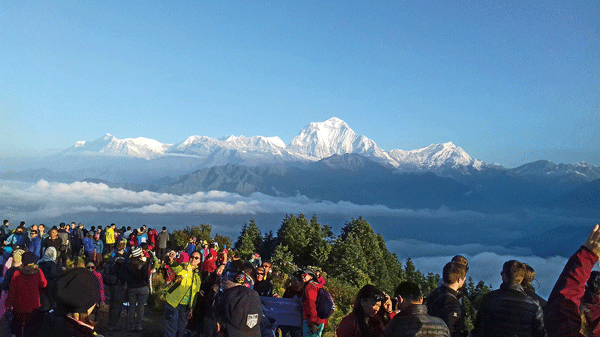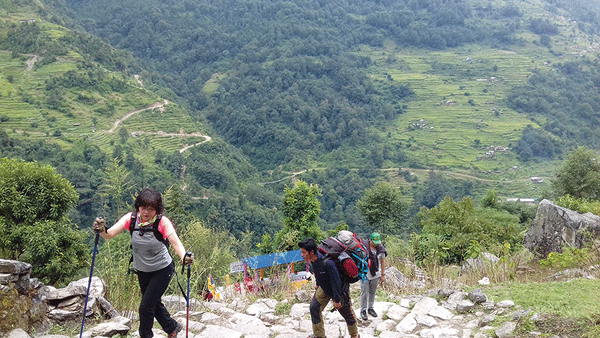
It was an impromptu decision. Together with three of my friends, I set off for an unplanned trek to the Annapurna region. And, it was just after the Dashain festival. Even during the peak festival season, the tourist buses departing from Kantipath were jam-packed. Not with foreigners, but with Nepalis. This signals the growth of domestic tourism in recent times.
Everything—the bus, its pace, and the stopovers—all were fine; however, it took us an entire day to reach Pokhara due to the sorry state of the road. The Department of Roads has been widening this road stretch for years, and it’s still a work in progress. Reaching Pokhara, we chose to stay at peaceful dam-side, rather than the crowded and noisy lakeside. And our decision was right! From our hotel room, we could see a corner of Phewa Lake and the early morning the reflection of Machhapuchhre was there on the still lake waters. Purely magical!
Start early, be on time
Next morning, we took a microbus from dam-side to Hari Chowk and caught an early bus going to Ghandruk. In an hour or so, we reached Birethanti, and from there we started our trek to Ghorepani. Make sure you register your name at the Annapurna Conservation Area Check Post and Information Center at Birethanti. The brochures at the center are quite helpful during the trek.
It’s sad that the gravel road runs along the trek route. While the scenery was beautiful, and the air was fresh, we would occasionally be buried in billows of dust and smoke coming from the jeeps plying on the road. However, it was pleasing to bypass the road and continue the trek through villages in between. Thanks to the local people and the Annapurna Conservation Area Project, you’ll never get lost. There are signs everywhere on the trekking route.

Reaching Hile, as we enquired about the remaining distance, everybody advised us to target reaching Ulleri by the evening and continue the trek to Ghorepani the next day. However, we walked briskly and reached Ulleri at lunch time. But, I would advise not to rush. Take time to enjoy nature—the waterfalls, butterflies, wild flowers, and the beautiful traditional houses along the route.
Rest, recharge, resume
As we crossed a suspension bridge after Tikhedhunga, the climb to Ulleri was steep; an uphill trek at an 80 degree slope, and it was a two-hour trek! Since it was the first day of our trek, the climb seemed invincible, and we had to take a rest several times along the way before we reached there for lunch. The lesson I learnt after crossing the stretch: rest, recharge, and resume. As the popular Nepali adage says, it’s not the food but the hunger that makes your food tasty. The food we had was one of the tastiest, although it was only daal bhaat and tarkari!
By that time, our legs were tired, but our spirit was alive and kicking. So, we continued the trek. After completing the stretch to Ulleri, the rest of the trek was a piece of cake. As we stopped for ginger tea at a lonely tea house, there was a sudden downpour. And the tea was heavenly!
As the sun started setting, we reached Ghorepani. We had no energy left to get to the main market at Ghorepani. So, we settled for a lodge nearest to the entrance gate of Ghorepani. The lodge was cheap but clean, Rs.1000 per person for bed, dinner, and breakfast. After a hot shower, we gathered around the fireplace and made friends with other trekkers from Canada, Egypt, and Korea. After dinner, we slept like babies!
Poon Hill craze
Next day, we woke up around four and headed towards Poon Hill. The climb, again, was steep and strenuous, like that of Ulleri, but perhaps it was the early morning fresh air, or the good night’s sleep, our legs kept moving at a steady pace, and within 45 minutes we were at Poon Hill. While Ghorepani is at an altitude of 2874 m, Poon Hill is at an altitude of 3210 m. Gushes of cold wind blow here all the time, so be well wrapped. To beat the cold, we had hot coffee at the only available tea shop there. Soon, the place became crowded with people from everywhere; I could see Koreans, Chinese, Indians, Europeans, and Americans; not to forget the domestic tourists from Nepal. We took our places on the platform and waited for the sun to rise. The sunrise was spectacular—we could easily distinguish the highest peaks. The sun’s rays lit the Dhaulagiri and Annapurna I peaks, and then it shone upon other peaks in the range, namely, Nilgiri, Annapurna South, Himchuli, and Machhapuchhre.
People try to take good pictures and videos from Poon Hill and flood their social media accounts with their personal stories. Some try to get a levitating pose, others pose doing yoga and acrobatics, and some try to get souvenir pictures with their national flags and expedition banners. It’s crowded, and the scene from this point makes everybody crazy. There’s not a single person who wouldn’t admire the beauty of the Himalayan range so close to their eyes. I could imagine how lovely it would be during the rhododendron blooming season!

A biodiversity hub
After capturing images of mighty Himalayan peaks and the glorious sunrise in our cameras, we descended down to our lodge and had a heavy breakfast. There was again a whole day’s trek to reach Ghandruk.
The trek from Ghorepani to Ghandruk was much easier, with lots of shade, water streams, and loads of mist. The route has many uphill climbs, followed by steep downhill descents, and I enjoyed the journey to the fullest. But, the only thing that disheartened me were the concrete culverts constructed to cross the streams. Why can’t the Annapurna Conservation Area Project continue mending the wooden bridges across the streams? It would look more natural and do good to the environment.
This stretch is very rich in biodiversity. You’ll come across hundreds of wild flowers. So, have your camera ready all the time, and if you’re a macrophotography enthusiast, then it’s heaven for you! There are rhododendron jungles all the way on this trekking route. The trees are so tall and old that you’ll never believe that they’re of rhododendrons. All the time, I was imagining what this route would look like during March-April. I could only imagine a sea of red!
We had a sumptuous lunch at Thadapani on the way to Ghandruk. The wild mushroom curry and green vegetables were tastier than any other food we had had in the last few days!
_rt.gif)
Changing perceptions
As we reached Ghandruk, we started our search for the night’s accommodation. A lodge owner, we met on the way, said, “We had two rooms, but I just lent one to a foreigner. If you guys want, I will ask her to leave and give the rooms to you.” We said no, and asked why, to which he replied, “Nepalis and Koreans spend a lot on food and alcohol and we do better business with them.” I had heard stories of lodge owners in Ghandruk not even caring to look at the domestic tourists, and only a few minutes earlier, three lodge owners had said that they were fully booked. But it was a different story there. The times they are a-changing!
After enquiring at a few more places, we were lucky enough to get two rooms at a small but clean lodge. All the lodges, hotels, and homestays were fully booked! And why wouldn’t they be? You can reach here from Pokhara in a single day, and most of the Nepali families either take a jeep or taxi to Kimche and then trek for an hour or more to get here.
In the morning, we could see Annapurna South, Himchuli, and Machhapuchhre right in front of our eyes. The sunrise and the close-up view of the mountains is enough to take away the pain and fatigue from the previous days’ walk. If you’re a first timer, a tour around the village is a must to get to know about the culture and tradition of Gurungs, the original inhabitants of Ghandruk.
With memories to cherish, I said good-bye to this beautiful village, but with a firm promise to visit again!










